
Big volcanoes look like this

(Mount Rainier, Washington)
The BIGGEST volcanoes look like this

Or this
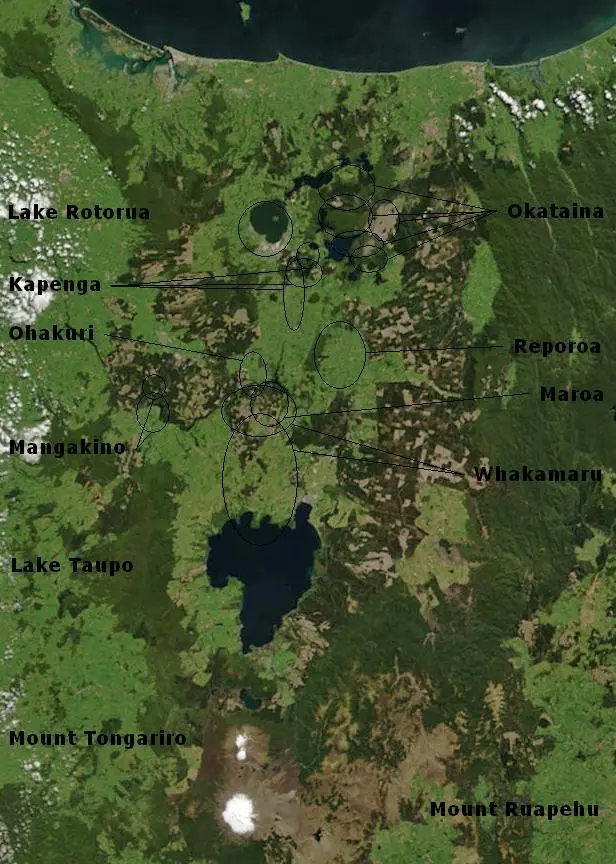
Notice how they don’t have that nice big pretty volcano cone shape? It just looks like some drunk geologists scribbled on a map and drew circles around a low lying area with a lake or two in it and called it a “volcano” or a “volcanic zone”.
The reason though is that the BIGGEST and most destructive volcanic eruptions tend to happen with lava/magma that doesn’t flow very well and like when you get a stuffed nose, everything gets blocked up. Like many of us, these volcanos don’t solve the problem and go take a decongestant or blow their nose, they just sit there sniveling and stewing, failing to release the pressure that keeps building and building and building.
These eruptions are called felsic eruptions (the opposite of mafic, goopy eruptions you have seen footage of from Hawaii where the lava comes out like a fluid). An immense amount of gas is released by magma as it becomes exposed to the surface (which then we call it “lava”) as the gas is no longer kept in the magma at immense pressures. The magma can’t flow and “pass the gas” so to speak so a plug forms and what you get is a terrifyingly big pressure cooker that just builds and builds like that person on the plane next to you that just keeps sniffing and sniffing and never blowing their nose.
When the built up pressure finally overcomes the plug, the resulting explosion is so catastrophic it doesn’t leave a clean volcano shape. What you are left with is an uneven low topography dotted with lakes that marks the site of an incomprehensibly large explosion, hence the topography of Yellowstone, Wyoming and the Taupo Volcanic Zone on the North Island of New Zealand.
TIME FOR SOME STATS THAT WILL BREAK YOUR BRAIN
"The Taupō Volcanic Zone has produced in the last 350,000 years over 3,900 cubic kilometres (940 cu mi) material, more than anywhere else on Earth, from over 300 silicic eruptions [my edit: “Felsic” means “has lots of silica/silicic (silicic? seriously wikipedia?) and wants to form minerals high in silica like quartz and feldspar”], with 12 of these eruptions being caldera-forming. Detailed stratigraphy in the zone is only available from the Ōkataina Rotoiti eruption but including this event, the zone has been more productive than any other rhyolite predominant volcanic area [my edit: Rhyolite is a record of catastrophe, it is a Felsic, silica-rich igneous rock like Granite except it cooled FAST at the surface instead of in big underground “batholiths” (that make up a good portion of the Canadian Shield and the NE of the US among other places) where the minerals had time to grow into big pretty crystals, same ingredients as Granite but with much more exciting baking instructions] over the last 50,000 odd years at 12.8 km3 (3.1 cu mi) per thousand years. Comparison of large events in the Taupō volcanic zone over the last 1.6 million years at 3.8 km3 (0.91 cu mi) per thousand years versus with Yellowstone Caldera’s 2.1 million year productivity at 3.0 km3 (0.72 cu mi) per thousand years favours Taupo…
…The last major eruption from Lake Taupō, the Hatepe eruption, occurred in 232 CE. It is believed to have first emptied the lake, then followed that feat with a pyroclastic flow that covered about 20,000 km2 (7,700 sq mi) of land with volcanic ash. A total of 120 km3 (29 cu mi) of material expressed as dense-rock equivalent (DRE) is believed to have been ejected, and over 30 km3 (7.2 cu mi) of material is estimated to have been ejected in just a few minutes."…
^https://en.wikipedia.org/wiki/Taupō_Volcanic_Zone
…“The main extremely violent pyroclastic flow travelled at close to the speed of sound and devastated the surrounding area, climbing over 1,500 m (4,900 ft) to overtop the nearby Kaimanawa Ranges and Mount Tongariro, and covering the land within 80 km (50 mi) with ignimbrite [my edit: the name for pyroclastic flow deposits, i.e. pumice and ash, that kind of thing]. Only Ruapehu was high enough to divert the flow. The power of the pyroclastic flow was so strong that in some places it eroded more material off the ground surface than it replaced with ignimbrite. There is evidence that it occurred on an autumn afternoon and its energy release was about 150 megatons of TNT equivalent. The eruption column penetrated the stratosphere as revealed by deposits in ice core samples in Greenland and Antarctica.”
^https://en.wikipedia.org/wiki/Taupō_Volcanic_Zone
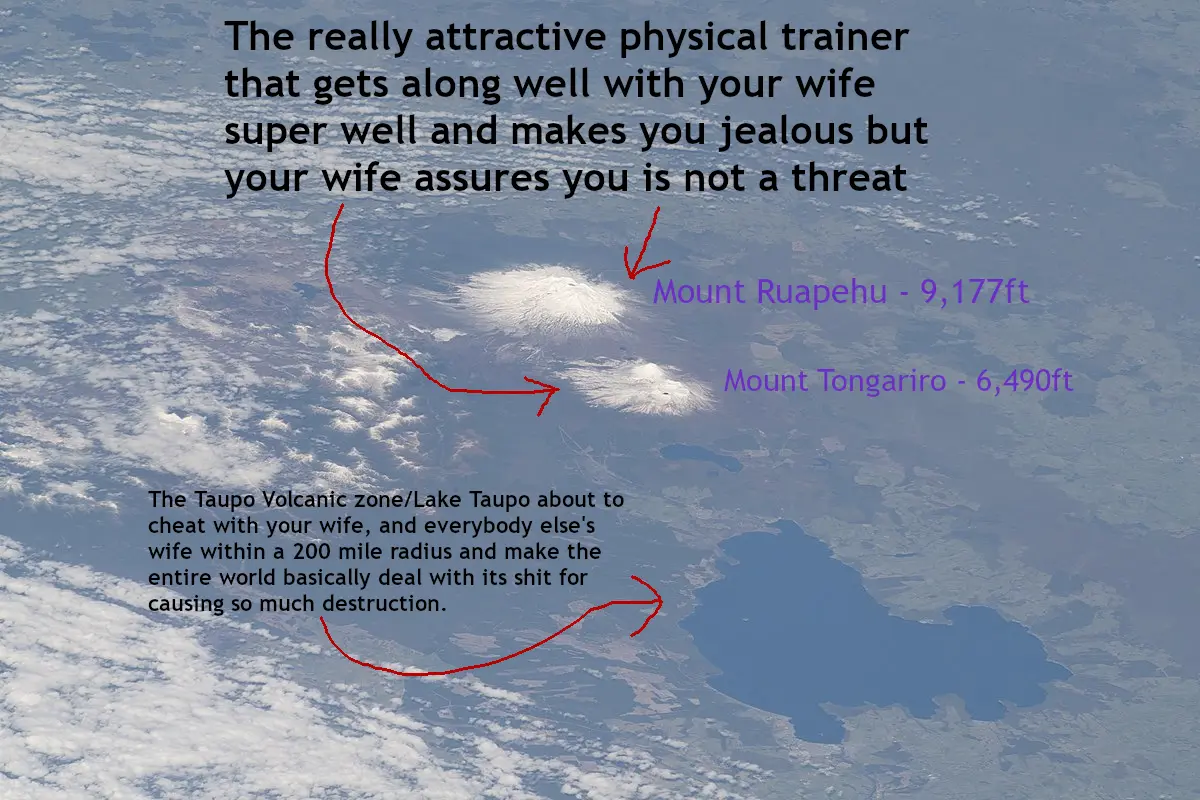
why the did I make this stupid meme in feet instead of metric, I am such an asshole -facepalm

Made me whip out my geology notes I took a few semesters ago, thanks for the fun explanation

Hell yeah!

I’m currently in college getting my major with something in education and that comment, that’s the energy I want to capture

Lies spread by Big Volcano
Wake up sheeple

Ohhh, I had no idea there were different kinds of volcanoes but it does make sense in hindsight.
Well, I guess this might have been covered in primary or secondary education at some point but it’s been about 3000 years since my last geography class

yo geolooggggyyyyyyy (lots of good brain food I promise)
There is a wonderful diverse world of volcanic eruptions! One thing you might not have thought about is how glaciers often form at the top of large cone volcanoes and the way the lava erupting interacts with a large volume of ice can shape the eruption significantly. One of the biggest results are lahars, like muddy, liquidy avalanches but even faster and deadlier.
https://www.usgs.gov/programs/VHP/lahars-move-rapidly-down-valleys-rivers-concrete
To give you a good point of reference though, one thing that links all volcanic eruptions and is a good axis for comparison between different eruptions and volcanoes is that all magma pretty much comes up from the interior of the earth to the near surface starting at the same chemical composition (called “mafic” it sounds like “basic”). Mafic minerals are heavy, dense and tend to be dark colored when viewed in a hand specimen, a common mafic rock is Basalt. Most of the oceanic crust is basalt.
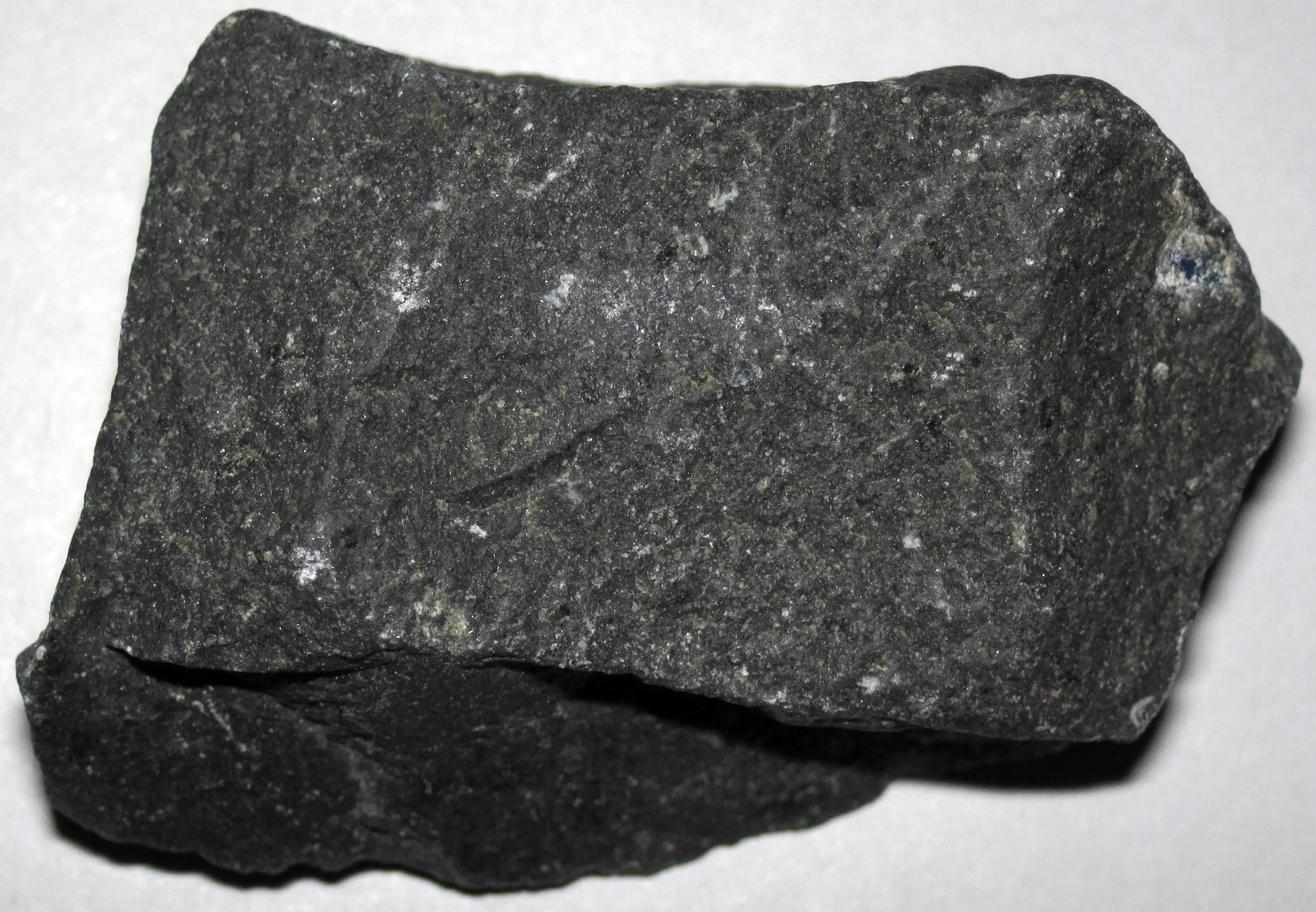
Available Wherever You Get Your Bottoms Of Oceans
Felsic minerals tend to be light both in mass and in coloring, a comon felsic rock is Granite.

Looks like your mom’s countertop, I remember it well how perfectly the skin of her naked legs complemented the gorgeously polished crystal textures of quartz, potassium feldspar (K-feldspar), sodic plagioclase feldspar, hornblende amphibole, and mica
This is a graph of Viscosity, the more Viscous the Magma the less ability it has to flow like a liquid (and thus the more likely a plug is likely to form inside a volcano). It is also more difficult for lower temperature magma to flow, and Felsic lava is almost always lower temperature (cooling had to occur to become Felsic in the first place so).
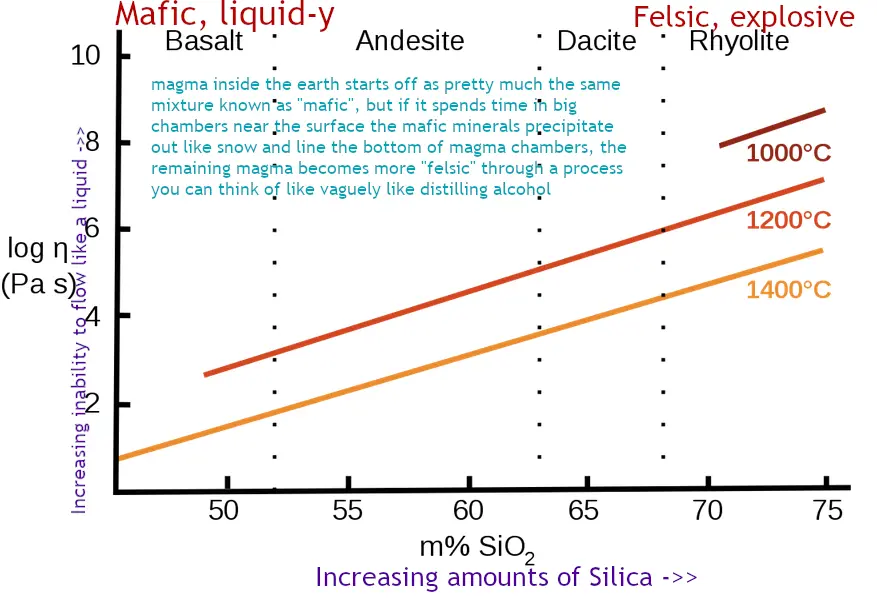
https://en.wikipedia.org/wiki/Magma
Here is something to ground these two ends of what probably seems like an arbitrary spectrum to focus on, the Oceanic Crust (i.e. the bottom of the ocean) on this planet is overwhelmingly made up of mafic rocks (i.e. Basalt) and large amounts of felsic rocks only really form on continental plates where there is the space and depth of rock to house massive chambers of magma, especially since Oceanic Plates are always getting subducted and recycled unlike Continental Plates (and thus the magma might be subducted & recycled before it could even begin the process of becoming significantly felsic). This axis of chemistry is critical to Geologists because it points directly to some of the biggest trends of geology on the planet and a related fact I might as well drop here is that because of these dynamics Continental Plates (i.e. basically the continents) can be orders of magnitude older (on the order of 1 billion years or older, the earth is only 4 or so billion years old) than oceanic crust which tends to be younger than 200 million years old (and often is much younger).
On Continental Plates if magma feeds into large underground chambers (batholiths) and is allowed to cool slowly then certain minerals will begin to form and precipitate out like snow that layers up on the bottom of the chamber. The specifics of what minerals these are depends on how long, how hot, how much pressure and other factors but you can vaguely think of it as a process of distillation where magma progresses from the original “mafic” composition to a “felsic” one as the high temperature mafic minerals crystallize out leaving behind a progressively more felsic magma mixture. The felsic minerals don’t crystallize out until the magma has significantly cooled and thus if the magma chamber undergoing this process is integrated into an eruption, it can become extremely explosive and destructive.
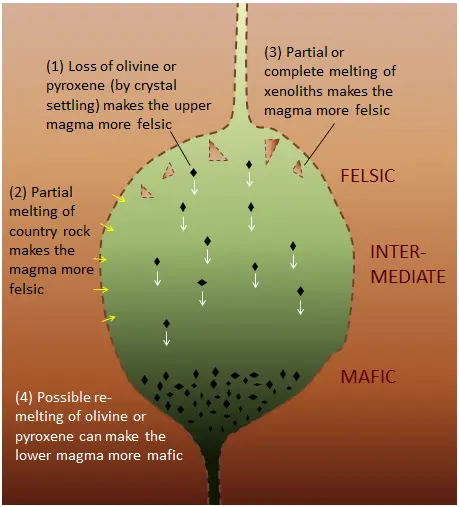
https://opentextbc.ca/geology/chapter/4-2-magma-composition-and-eruption-style/
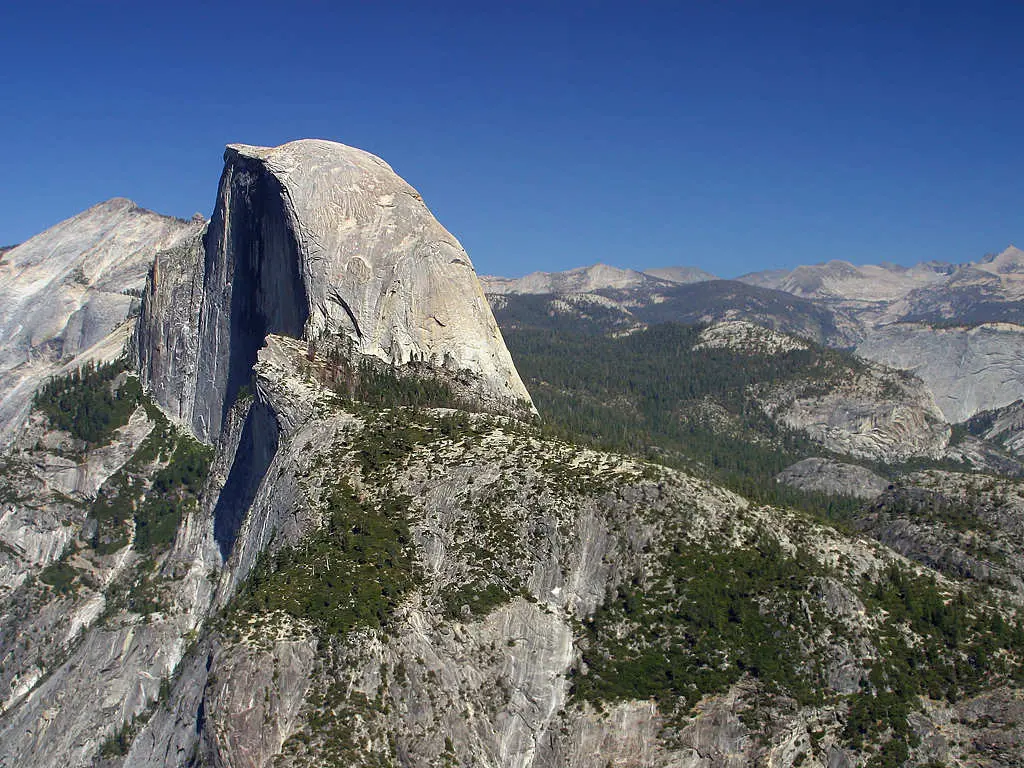
Half Dome in Yosemite California is such a trip because it is so clearly what we imagine in geology when we talk about a really big underground chamber of magma (after it has cooled into rock obv), Half Dome just looks like exactly how you would imagine it if you dug up an old magma chamber and cracked in half with a suitably large hammer

Huh, interesting. I didn’t expect to learn about volcanoes today but here I am! Thank you for the explanation

Thank you, kind geology enthusiast.
Really barely comprehensible how immense those volcanic activities are.
On a side note, you’ve listed insane unit after insane unit of death and destruction. And then there is this sentence:
There is evidence that it occurred on an autumn afternoon
That was a cute turn and I laughed. :D

Except Vesuvius, which looks like a volcano, but in 79CE erupted violently sending lave, magma and molten rocks several kilometers away, exactly like the stuffy nose you described. It completely destroyed Pompeii and Herculaneum, burying them for thousands of years.

Still nothing when compared to the destruction that the “Campi Flegrei” volcano brought 37’000 years ago, completely burying a huge section of the Campanian coastline.


Super cool!!
Aain I love how it looks like a drunk geologist made a big scribble on a map and said before passing out “that Campi Flegrei, that’s a BIG one right there!” and you are just left looking at the map being like… what… are you sure that just looks like you randomly circled a huge part of the landscape?..like… really the whole bay?

Yeah, it pretty much blew out that whole section of coastline, that big hole is called a “caldera”. It’s still active btw, you can go and check it out if you want. Look for Solfatara di Pozzuoli.
You can also look at the Greek island of Santorini, where the whole western and central part of the island was blown off during the bronze age iirc. Historians speculate the eruption, earthquake and tsunamis caused by the event could have partially influenced the collapse of the Minoan civilization, the rise of the Mycenaeans, turmoil in Egypt and possibly even the fall of the Chinese empire due to a global winter. Crazy stuff


Are we just a bunch of crazy conspiracy theorists sitting in dark rooms with a computer and pinboard against the wall, complete with strings between posted mugshots of lava domes and dikes, muttering to ourselves as we circle vaguely roundish things on a map in red ink and exclaim “ANOTHER!!!” ??
No, we are usually in the middle of nowhere in the woods hiking erratically across the landscape with nobody around so we tend to shout at things more than mutter because why not.

“Success! We have plugged the volcano!”
two days later


didnt use enough cement

Definitely! I find that most problems in life can be solved with cement; if it didn’t solve your problem, you just didn’t use enough of it.
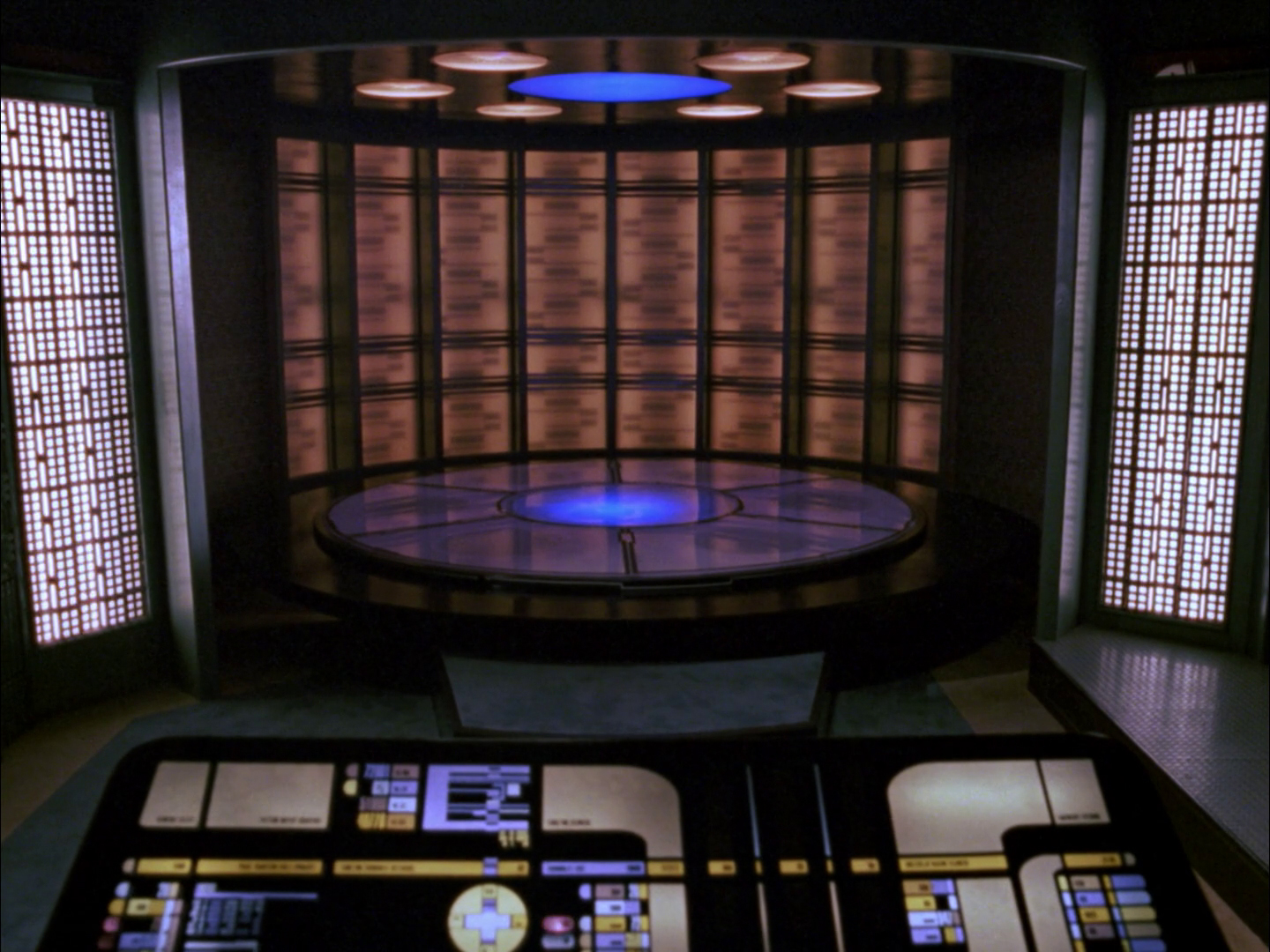
I need about a moon-sized glob of cement for…
Science stuff.

Add duct tape to the list

Where is this from?? Is this AI?

I believe that’s Mt St Helens erupting. Real footage from 1980 (though this gif is sped up).

Thank you, I just read the Wikipedia summary of the event, and I can’t believe this isn’t even as big as the “Big One” everyone talks about for Yellowstone.

Mt, St. Helen compared to Yellowstone or the Phlegraean Fields in Italy was an a simple New Year’s Eve rocket. Both capable to create an month long night on the whole Earth.

Mt. St. Helen’s eruption, 1980. I remember this form when I was a kid. I couldn’t wrap my head around a mountain exploding then, and I still can’t.

Where is this from?? Is this AI?
At this point in Earth’s timeline (1980) AI had not yet gained control of Earth’s volcanoes through a projection network of 80s music into the asthenosphere so this indeed was a naturally occurring volcano as opposed to Uber or Amazon.

Now we have lava and a cement projectile!

This requires a lot of concrete. A more economical solution would be to just move the volcano elsewhere. Plus then you can sell all of the new real estate where the volcano once stood!
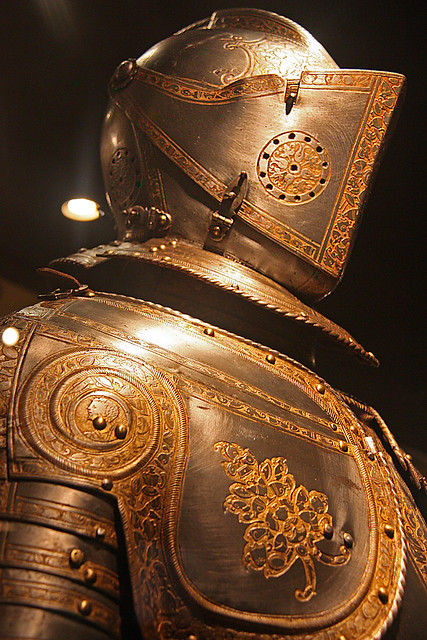
Given the state of the world, those volcanoes are probably already owned by foreign investors to use as land banks.

You’re missing the bigger picture. Move the volcano to the ocean. Then bit by bit you get some land that you can sell later when you want to retire. Kind of like the plot to that super man movie.

I like how the diagram contains an illustration of one big flaw in the plan

Wanna know my pet peve? I just know whoever honestly asked that question did zero research at all about it but instead of asking if anyone has ever done it they ask why no on ever has, even though I just know they didn’t so much as google it once.

It’s the same people who post “what time does big Tesco shut?” on Facebook.

What time does Yellowstone erupt tho?

Just put up some “no eruption” signs.

The sign won’t do much good without force of law. We need legislation outlawing these eruptions.

That goes without saying. We need to regulate volcanic burp strength, ejaculation mass and toxic fumes. Pyroclastic flows as well.

But if we regulate burp strength, ejaculation mass, and toxic fumes, my husband won’t have any hobbies left!

That’s harsh. He might get a permit if he promises to not kill entire villages at a time.

Good idea, also applicable in other areas


Also fun fact - you can make a gun ineffective and safe just by welding shut its barel.

Ineffective, definitely.
Safe for the target, also maybe. Just depends on whether the exploding action and barrel throw shrapnel down range, or if you had a shitty weld. Guy holding it won’t have a good day, but could survive. Something something Kentucky ballistics.
Idk man, this plan is sounding pretty credible.
Wait, wrong community…

yeah a pretty credible way to defend yourself against your target

Read somewhere in an book that sometimes soldiers/aides tried to hurt/kill their officers my minimally reducing their barrel width mechanically when cleaning their pistols for them. Hard to detect and can fuck someone up good.
But while I can see how that would work in theory I don’t see how this could be done without someone noticing it and with the tools at their disposal.

Just pump out the magma til it’s empty and use it to heat homes. Win win

I’m absolutely sure this wouldn’t work but I need to know why it wouldn’t work

Simple. What are you going to pump it with? If you have something you can contain magma in to pump it around, why not just build everything out of that and not worry about the magma anymore?

- cement: mostly not rocks and mortar mix or whatever the fuck
- concrete: mostly rocks, mortar mix, and significantly stronger than cement.
- lava: literally actually just fucking molten rock
- also lava: buried thousands of feet deeper below millions, possibly billions of pounds of more rock
- concrete: weights about the same
shitposting aside this would just spray incredibly small chunks of solidified lava everywhere, for miles.

It’s like expecting the pipe of a pipe bomb to contain the explosion

i mean, it does contain it, so uh.
It just won’t contain it forever.

Brilliant! Sign this $1B invoice and I’ll setup a team for a proof of concept.

This has the vibe of “Grifting a bunch people who have no sense and a way too much money on their hands”. I’m in.
Edit: Missed a word

When Kilauea was making news for erupting, I showed my (now ex) partner a photo of the lava flow over the road with hazard barriers to keep people away.
Her response was to ask why they didn’t just divert the flow away from where people are.

They actually do that with earth barriers sometimes, e.g. at the Aetna.
But there is only so much these barrier can do…

Because that’s the avatar’s job and he went missing… Again

Every time we need him
I’m starting to bet that guy isn’t even magic

I mean yeah, why instead of writing “people stay away” don’t they just put “lava stay away”?

If we put enough corn kernels it would fill up the volcano with popcorn and it will just shoot popcorn all over the tri state area 🧠

Did she ever pop a pimple? Volcanoes build up an insane amount of pressure.

